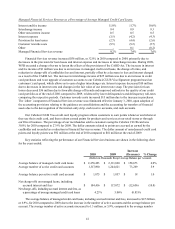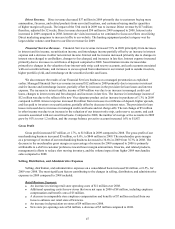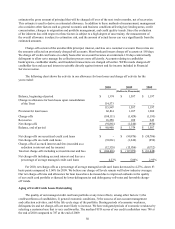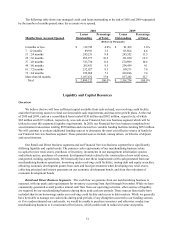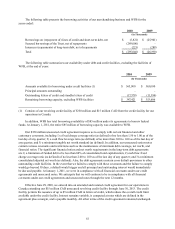Cabela's 2010 Annual Report Download - page 59
Download and view the complete annual report
Please find page 59 of the 2010 Cabela's annual report below. You can navigate through the pages in the report by either clicking on the pages listed below, or by using the keyword search tool below to find specific information within the annual report.
49
Provision for Income Taxes
Our effective tax rate was 35.2% in 2009 compared to 35.4% in 2008. The effective tax rate for 2009 was
reduced primarily by our international restructuring completed in August 2009. The effective tax rate for 2008 was
impacted by the corporate restructure completed in April 2008 and the release of valuation allowances relating to
state net operating losses realized in 2008.
Bank Asset Quality
Delinquencies and Non-Accrual
We consider the entire balance of an account, including any accrued interest and fees, delinquent if the
minimum payment is not received by the payment due date. Our aging method is based on the number of
completed billing cycles during which a customer has failed to make a required payment. As part of collection
efforts, a credit card loan may be closed and placed on non-accrual or restructured in a fixed payment plan prior to
charge off. Our fixed payment plans consist of a lower interest rate, reduced minimum payment, and elimination of
fees. Loans on fixed payment plans include loans in which the customer has engaged a consumer credit counseling
agency to assist them in managing their debt. Non-accrual loans with two consecutive missed payments will
resume accruing interest at the rate they had accrued at before they were placed on non-accrual. Payments received
on non-accrual loans will be applied to principal and reduce the amount of the loan. The following chart shows
delinquent, non-accrual, and restructured loans as a percentage of our managed credit card loans, including any
accrued interest and fees, at the years ended:
2010 2009 2008
Number of days delinquent and still accruing:
Greater than 30 days 0.74%1.07%1.15%
Greater than 60 days 0.47 0.66 0.67
Greater than 90 days 0.25 0.36 0.34
Non-accrual 0.24 0.18 -
Restructured (excluded from percentages above) 2.90 3.52 1.95
The following chart reports delinquencies as a percentage of our managed credit card loans, including any
delinquent non-accrual and restructured credit card loans, that is consistent with our monthly external reporting for
the years ended:
2010 2009 2008
Number of days delinquent:
Greater than 30 days 1.13%1.79%1.68%
Greater than 60 days 0.72 1.09 0.97
Greater than 90 days 0.37 0.56 0.47
We have devoted significant attention to processes which will mitigate our charge-offs. These processes
include changes in our collection strategies and practices that proactively promote fixed payment and non-accrual
plans to certain cardholders as necessary.
Allowance for Loan Losses and Charge-offs
The allowance for loan losses represents management’s estimate of probable losses inherent in the loan
portfolio segment. The allowance for loan losses is established through a charge to the provision for loan losses and
is regularly evaluated by management for adequacy. Management estimates losses inherent in the credit card loans
and restructured credit card loans based on a model which tracks historical loss experience on delinquent accounts
and charge-offs, net of estimated recoveries. WFB uses a migration analysis that estimates the likelihood that a
credit card loan will progress through the various stages of delinquency and to charge-off. The migration analysis




